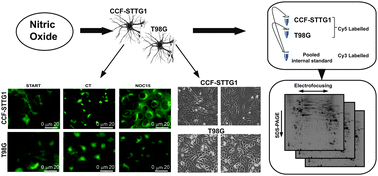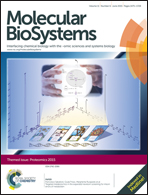Proteomic analysis of human glioblastoma cell lines differently resistant to a nitric oxide releasing agent†
Abstract
Glioblastoma multiforme is the most aggressive astrocytoma characterized by the development of resistant cells to various cytotoxic stimuli. Nitric oxide (NO) is able to overcome tumor resistance in PTEN mutated rat C6 glioma cells due to its ability to inhibit cell growth by influencing the intracellular distribution of ceramide. The aim of this study is to monitor the effects of NO donor PAPANONOate on ceramide trafficking in human glioma cell lines, CCF-STTG1 (PTEN-mutated, p53-wt) and T98G (PTEN-harboring, p53-mutated), together with the assessment of their differential molecular signature by 2D-DIGE and MALDI mass spectrometry. In the CCF-STTG1 cell line, the results indicate that treatment with PAPANONOate decreased cell proliferation (<50%) and intracellular trafficking of ceramide, assessed by BODIPY-C5Cer, while these events were not observed in the T98G cell line. Proteomic results suggest that CCF-STTG1 cells are characterized by an increased expression of proteins involved in NO-associated ER stress (i.e. protein disulfide-isomerase A3, calreticulin, 78 kDa glucose-regulated protein), which could compromise ceramide delivery from ER to Golgi, leading to ceramide accumulation in ER and partial growth arrest. Conversely, T98G cell lines, resistant to NO exposure, are characterized by increased levels of cytosolic antioxidant proteins (i.e. glutathione-S-transferase P, peroxiredoxin 1), which might buffer intracellular NO. By providing differential ceramide distribution after NO exposure and differential protein expression of two high grade glioma cell lines, this study highlights specific proteins as possible markers for tumor aggressiveness. This study demonstrates that, in two different high grade glioma cell lines, NO exposure results in a different ceramide distribution and protein expression. Furthermore, this study highlights specific proteins as possible markers for tumor aggressiveness.

- This article is part of the themed collection: Proteomics

 Please wait while we load your content...
Please wait while we load your content...